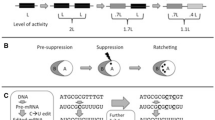Abstract.
The neutral theory often is presented as a theory of ``noise'' or silent changes at an isolated ``molecular level,'' relevant to marking the steady pace of divergence, but not to the origin of biological structure, function, or complexity. Nevertheless, precisely these issues can be addressed in neutral models, such as those elaborated here with regard to scrambled ciliate genes, gRNA-mediated RNA editing, the transition from self-splicing to spliceosomal splicing, and the retention of duplicate genes. All of these are instances of a more general scheme of ``constructive neutral evolution'' that invokes biased variation, epistatic interactions, and excess capacities to account for a complex series of steps giving rise to novel structures or operations. The directional and constructive outcomes of these models are due not to neutral allele fixations per se, but to these other factors. Neutral models of this type may help to clarify the poorly understood role of nonselective factors in evolutionary innovation and directionality.
Similar content being viewed by others
Author information
Authors and Affiliations
Additional information
Received: 3 September 1998 / Accepted: 15 February 1999
Rights and permissions
About this article
Cite this article
Stoltzfus, A. On the Possibility of Constructive Neutral Evolution. J Mol Evol 49, 169–181 (1999). https://doi.org/10.1007/PL00006540
Issue Date:
DOI: https://doi.org/10.1007/PL00006540




